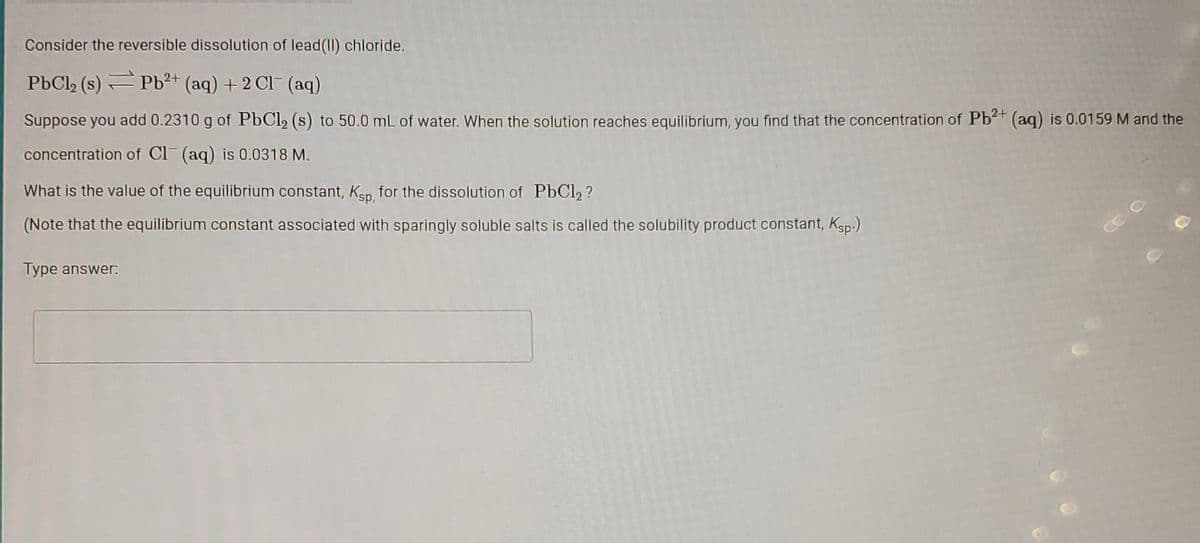Consider the reversible dissolution of lead(11) chloride. PbCl₂ (s) Pb²+ (aq) + 2Cl(aq) Suppose you add 0.2310 g of PbCl₂ (s) to 50.0 mL of water. When the solution reaches equilibrium, you find that the concentration of Pb2+ (aq) is 0.0159 M and the concentration of Cl(aq) is 0.0318 M. What is the value of the equilibrium constant, Ksp, for the dissolution of PbCl₂? (Note that the equilibrium constant associated with sparingly soluble salts is called the solubility product constant, Ksp.)
Consider the reversible dissolution of lead(11) chloride. PbCl₂ (s) Pb²+ (aq) + 2Cl(aq) Suppose you add 0.2310 g of PbCl₂ (s) to 50.0 mL of water. When the solution reaches equilibrium, you find that the concentration of Pb2+ (aq) is 0.0159 M and the concentration of Cl(aq) is 0.0318 M. What is the value of the equilibrium constant, Ksp, for the dissolution of PbCl₂? (Note that the equilibrium constant associated with sparingly soluble salts is called the solubility product constant, Ksp.)
Chemistry & Chemical Reactivity
10th Edition
ISBN:9781337399074
Author:John C. Kotz, Paul M. Treichel, John Townsend, David Treichel
Publisher:John C. Kotz, Paul M. Treichel, John Townsend, David Treichel
Chapter17: Principles Of Chemical Reactivity: Other Aspects Of Aqueous Equilibria
Section17.6: Equilibria Involving Complex Ions
Problem 1.4ACP: Silver undergoes similar reactions as those shown for gold. Both metals react with cyanide ion in...
Related questions
Question

Transcribed Image Text:Consider the reversible dissolution of lead(II) chloride.
PbCl₂ (s)
Pb²+ (aq) + 2Cl(aq)
Suppose you add 0.2310 g of PbCl₂ (s) to 50.0 mL of water. When the solution reaches equilibrium, you find that the concentration of Pb²+ (aq) is 0.0159 M and the
concentration of Cl(aq) is 0.0318 M.
What is the value of the equilibrium constant, Ksp, for the dissolution of PbCl2?
(Note that the equilibrium constant associated with sparingly soluble salts is called the solubility product constant, Ksp.)
Type answer:
Expert Solution
This question has been solved!
Explore an expertly crafted, step-by-step solution for a thorough understanding of key concepts.
Step by step
Solved in 2 steps with 2 images

Knowledge Booster
Learn more about
Need a deep-dive on the concept behind this application? Look no further. Learn more about this topic, chemistry and related others by exploring similar questions and additional content below.Recommended textbooks for you

Chemistry & Chemical Reactivity
Chemistry
ISBN:
9781337399074
Author:
John C. Kotz, Paul M. Treichel, John Townsend, David Treichel
Publisher:
Cengage Learning

Chemistry for Engineering Students
Chemistry
ISBN:
9781337398909
Author:
Lawrence S. Brown, Tom Holme
Publisher:
Cengage Learning

Chemistry & Chemical Reactivity
Chemistry
ISBN:
9781133949640
Author:
John C. Kotz, Paul M. Treichel, John Townsend, David Treichel
Publisher:
Cengage Learning

Chemistry & Chemical Reactivity
Chemistry
ISBN:
9781337399074
Author:
John C. Kotz, Paul M. Treichel, John Townsend, David Treichel
Publisher:
Cengage Learning

Chemistry for Engineering Students
Chemistry
ISBN:
9781337398909
Author:
Lawrence S. Brown, Tom Holme
Publisher:
Cengage Learning

Chemistry & Chemical Reactivity
Chemistry
ISBN:
9781133949640
Author:
John C. Kotz, Paul M. Treichel, John Townsend, David Treichel
Publisher:
Cengage Learning

Introductory Chemistry: A Foundation
Chemistry
ISBN:
9781337399425
Author:
Steven S. Zumdahl, Donald J. DeCoste
Publisher:
Cengage Learning

Chemistry by OpenStax (2015-05-04)
Chemistry
ISBN:
9781938168390
Author:
Klaus Theopold, Richard H Langley, Paul Flowers, William R. Robinson, Mark Blaser
Publisher:
OpenStax

Chemistry: Principles and Practice
Chemistry
ISBN:
9780534420123
Author:
Daniel L. Reger, Scott R. Goode, David W. Ball, Edward Mercer
Publisher:
Cengage Learning